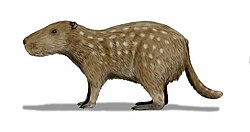| Hystrix Temporal range: Early Miocene - Recent | |
|---|---|
 | |
| Hystrix indica (Henry Vilas Zoo, Madison, Wisconsin) | |
| Scientific classification | |
| Kingdom: | Animalia |
| Phylum: | Chordata |
| Class: | Mammalia |
| Order: | Rodentia |
| Family: | Hystricidae |
| Genus: | Hystrix Linnaeus, 1758 |
| Type species | |
| Hystrix cristata Linnaeus, 1758 | |
| Species | |
Hystrix africaeaustralis Contents | |
 | |
| Distribution of Old World porcupines | |
Hystrix is a genus of porcupines containing most of the Old World porcupines. Fossils belonging to the genus date back to the late Miocene of Africa. [1]
Hystrix (from Ancient Greek ὕστριξ (hústrix, “porcupine”) was given name by the 18th-century Swedish botanist Carl Linnaeus.














